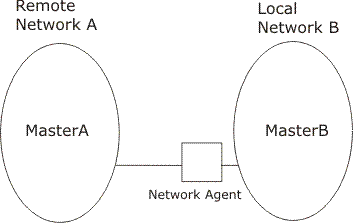A sample network agent definition
The following example shows how to define a network agent
workstation for a remote network, Network A, that
allows local network, Network B, to use jobs and
job streams in the remote network as internetwork dependencies.
Figure 1. Local and remote networks
Assuming that: 
- MasterA is the master domain manager of
the remote network, Network A, and that:
- tws_masterA is the TWS_user defined on MasterA.
- The TCP port number for MasterA as 12345.
- The node where MasterA is defined is MasterA.rome.tivoli.com.
- MasterB is the master domain manager of
the local network, Network B, and that:
- tws_masterB is the TWS_user defined on MasterB.
- The node where MasterB is defined is MasterB.rome.tivoli.com.
CPUNAME NETAGT
DESCRIPTION "NETWORK AGENT"
OS OTHER
NODE MASTERA.ROME.TIVOLI.COM
TCPADDR 12345
FOR maestro
HOST MASTERB
ACCESS netmth
ENDImportant: Write the network
access name netmth in lowercase on case-sensitive
operating systems.
The options file, netmth.opts defined
on MasterB can be:
GSuser=tws_masterB
GStimeout=600Note: The network agent can be defined on either the master domain manager or
a fault-tolerant agent.